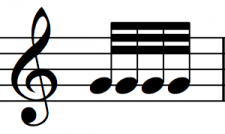

A good editor will note the inner groups clearly so that the performer can quickly ascertain how the internal rhythmic forms should be accented by placing strong beats at the beginning of each of the inner groupings. So 5 will break down into a group of 2 followed by a group of 3 or, alternatively, a group of 3 followed by a group of 2. The uneven numbers break down into shorter inner groups of either simple or compound rhythms. Time signatures in which the number of notes in the bar is odd (i.e. The formal distinction between simple and compound time or meter becomes blurred particularly in the folk music of central Europe and Asia Minor where the pattern of dances steps is complex. If a piece is so quick that the feeling is of one beat in a bar, then the triple meter (usually 3/2 or 3/8) is compound (i.e. We can list various time signatures as simple time signatures or compound time signatures.

If the piece is to be played 'three in a bar' then it should be notated in three, as it was in the first example. A performer would be confused - should the piece be in two or in three. The third score has a compound time signature. This is an example of compound time or tempo composto (Italian) the main beat can be divided into three inner beats, in this case quavers (eighth notes). Therefore, each bar contains six quavers (eighth notes). The beat is actually a dotted crotchet (dotted quarter note) but the beat is divided into three quavers (eighth notes). This score is written in six but 'felt' in two we have marked the pulse with dotted bar-lines. This is an example of simple time or tempo semplice (Italian) the main beat can be divided into two inner beats, in this case quavers (eighth notes). The beat is a crotchet (quarter note) and the time signature tells us that there are three crotchets (quarter notes) in each bar. This score is in 'three' we have marked the three beats with dotted bar-lines. Two of these are the same piece of music written in two different ways. This is illustrated in the three scores below. Sometimes time signatures might mislead the performer and we have adopted a 'convention' about how different time signatures relate to particular underlying rhythmic structures. Neither of these, unclear where bar-lines are absent, would not be clearer with bar-lines written into the score. So, for example, a bouree which has four beats in a bar starts on the last beat the gavotte, also written with four beat in a bar, starts on the third beat. Bar-lines and time signatures are used to make the underlying rhythm, the pattern of beats of differing weight (strong, medium, weak), clearer to the performer. Think of the beat as something 'you tap your foot to' when you are listening to a piece of music. We had a preliminary look at time signatures in lesson 4.Ī great deal of music, particularly that from the Western musical tradition, has an underlying pulse or beat. Simple & Compound Time/Meter :: Uneven/Asymmetrical Time/Meter :: Triplets :: Duplets :: Other-lets :: Grouping Notes and Rests My sole inspiration is a telephone call from a producer.Ĭole Porter (1893-1964) American composer

Previous lesson :: next lesson :: contents :: index :: manuscript paper :: comments or queries? To use the menu you must first enable javascript


 0 kommentar(er)
0 kommentar(er)
